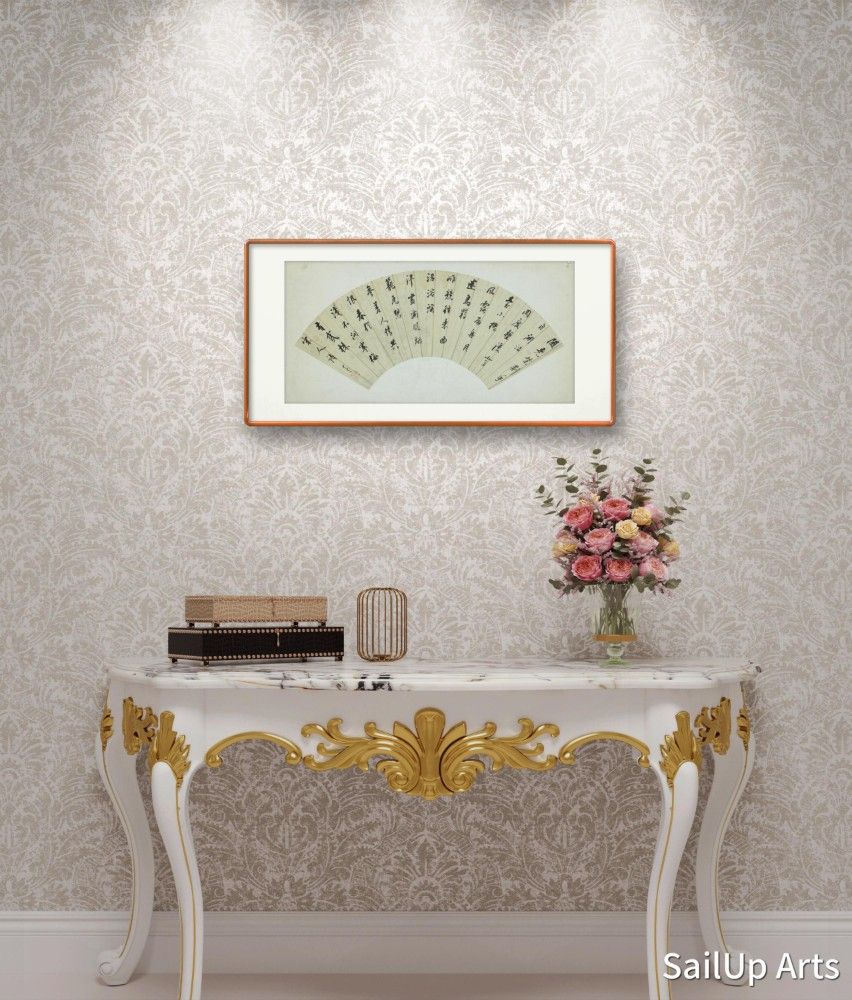


Artwork viewer
Click the image to view a larger version.
Running Script Fan "Two Poems by Sung Dynasty Poet Wang Anshi" (行書扇面“宋王安石詩二首”)
Zhu Angzhi 朱昂之
$3,900.00
Created in The 1800s
Ink on paper 紙本墨書
Mounted, without frame
Dimensions
Image: 24 cm x 54 cm (9 7/16" x 21 1/4")
Overall: 30 cm x 58 cm (11 13/16" x 22 13/16")
Excluding taxes: The price does not include purchase tax, value-added tax (VAT), or other taxes.Learn More
Free Shipping. We will contact you after your purchase to arrange shipping.Learn More
Artist
Zhu Angzhi 朱昂之
1764 - post 1841
Zhu Angzhi, courtesy name Qingli, also known as Jinli, was a native of Wujin, Jiangsu Province. In his later years, he resided in Wuzhong (modern-day Suzhou, Jiangsu). The son of the renowned Qing Dynasty calligrapher and painter Zhu Wenrong, Zhu Angzhi was deeply influenced by his family’s artistic traditions from a young age and excelled in both calligraphy and painting. Drawing inspiration from artists such as Yun Shouping and Wang Hui, he inherited traditional techniques while developing his own distinctive style. Zhu Angzhi was celebrated for his mastery in both calligraphy and painting. His calligraphy is characterized by vigorous and graceful strokes, blending elegance with individuality. His paintings, primarily landscapes, feature meticulous brushwork and a refined aesthetic, emphasizing the harmony between composition and artistic conception. During his middle years, Zhu Angzhi devoted himself to copying works of ancient masters, showcasing his profound artistic cultivation and technical expertise. As a Qing Dynasty literati, Zhu Angzhi upheld the ideal of integrating poetry, calligraphy, and painting into a unified form of artistic expression. His works, particularly his fan calligraphy and landscape paintings, were highly regarded and cherished by scholars and collectors. Zhu Angzhi’s artistic achievements not only reflect the refined beauty of traditional Qing Dynasty art but also leave a rich cultural legacy for future generations.
朱昂之,字青立,又字津里,江蘇武進人,晚年僑居吳中(今江蘇蘇州)。他是清代著名書畫家朱文嶸之子,自幼浸染家學,頗得書畫之妙。朱昂之的藝術造詣青出於藍,深受恽壽平與王翬的影響,並在繼承傳統的基礎上形成了自己獨特的書畫風格。 朱昂之以書畫並重著稱,其書法筆意勁峭,脫盡常規,線條靈動中蘊含力量,風格典雅而不失個性。其繪畫作品多以山水為題材,筆法工整秀美,注重構圖與意境的結合,深得古人神髓,尤其在中年時臨摹古人之作,顯示出極高的藝術修養與技法功底。 作為清代文人,朱昂之崇尚詩書畫三者合一的藝術理想,他的扇面書法和山水畫作品尤為出色,常被文人雅士珍藏。其藝術成就不僅體現了清代傳統書畫的典雅之美,也為後世留下了豐富的文化遺產。
Details
Inscription
隨意柴荆手自開,沿岡度塹復登臺。小橋風露扁舟月,迷鳥羇雌竟徃來。 曲沼溶溶泮尽澌,暖烟笼瓦碧参差。人情共恨春犹浅,不问寒梅有几枝。 宋人詩,昂之
Seal
1 seal of the artist, 昂之
Condition
The artwork is in excellent condition, though it shows signs of aging.
Description
This fan by Zhu Angzhi bears two poems by Wang Anshi written in running script, with an ink tone that is pure and flowing. The characters are arranged along the arc of the fan, alternating between upright and slanted forms, yet maintaining a unified rhythm throughout. The strokes often begin with hidden tips and are mostly executed with a centered brush. At the turning points, his skill is evident, with clear pauses and decisive movements. The character structures are slender, with measured expansion and contraction between the strokes. Large characters lead the visual rhythm, followed closely by smaller ones, creating a cadence like running water. The alternation of rich, pale, dry, and moist ink gives variety—dense ink like drops of lacquer, pale ink like distant clouds among peaks; in the open spaces, a breeze seems to flow, carrying a sense of stillness. The brushwork is unadorned yet full of literary grace, in harmony with the lofty and vigorous style of Wang Anshi’s poetry. In terms of composition, the first column is steady, the last column neatly gathered; the inscription and seals are placed in the lower corner, their red balancing the white space, anchoring the visual weight. The work as a whole is both elegant and upright, inheriting the plain naturalness of the Song masters while also showing the refined restraint of a Qing scholar. It is a piece suitable for refined display, inviting repeated appreciation. Although the fan ribs impose divisions, the brushwork flows freely, transforming rigidity into vitality. The spacing between characters alternates between tight and open, like the rhythm of breath. It is fit to be handled and admired on a scholar’s desk, and it reflects the shifts and self-contented ease of late Qing literati calligraphy, with an enduring charm.
$3,900.00


